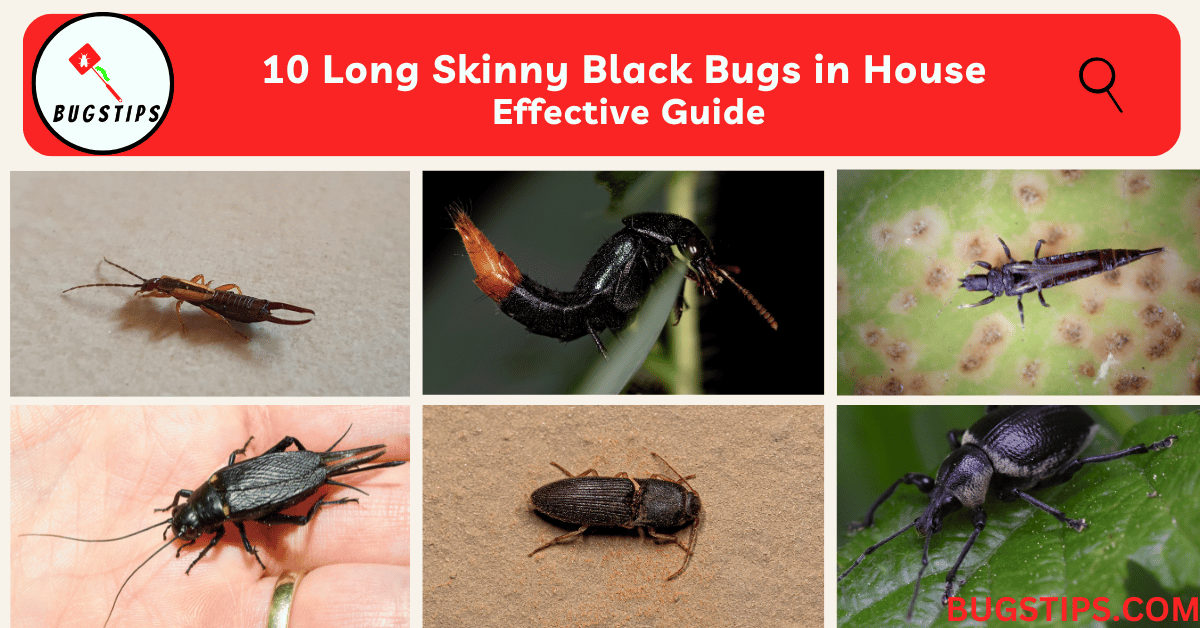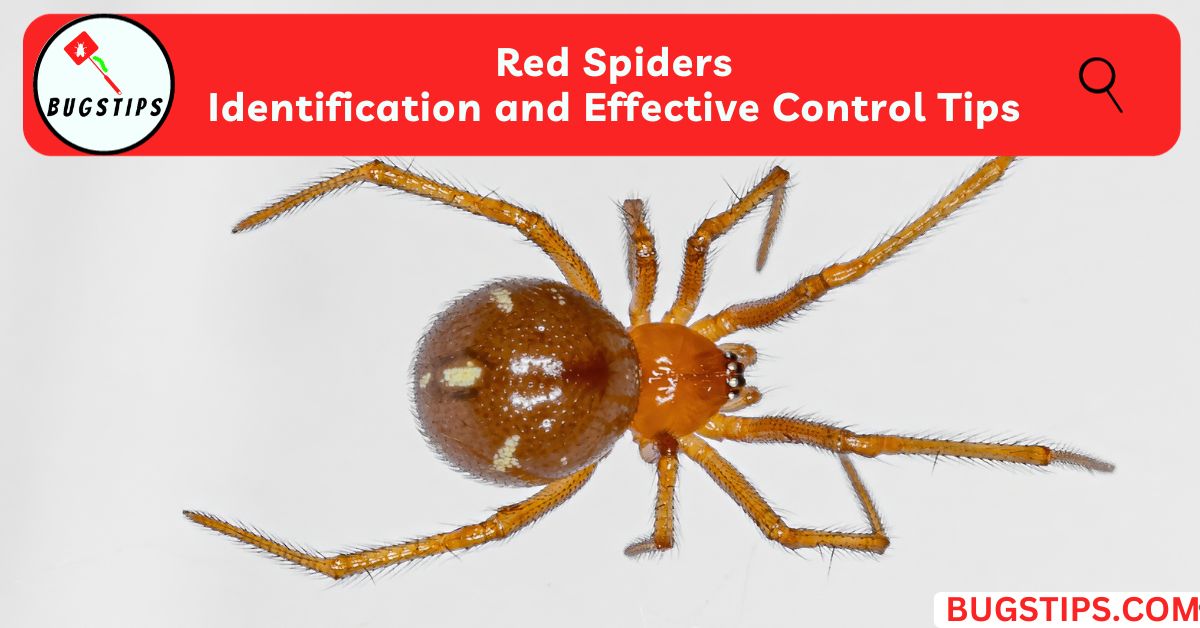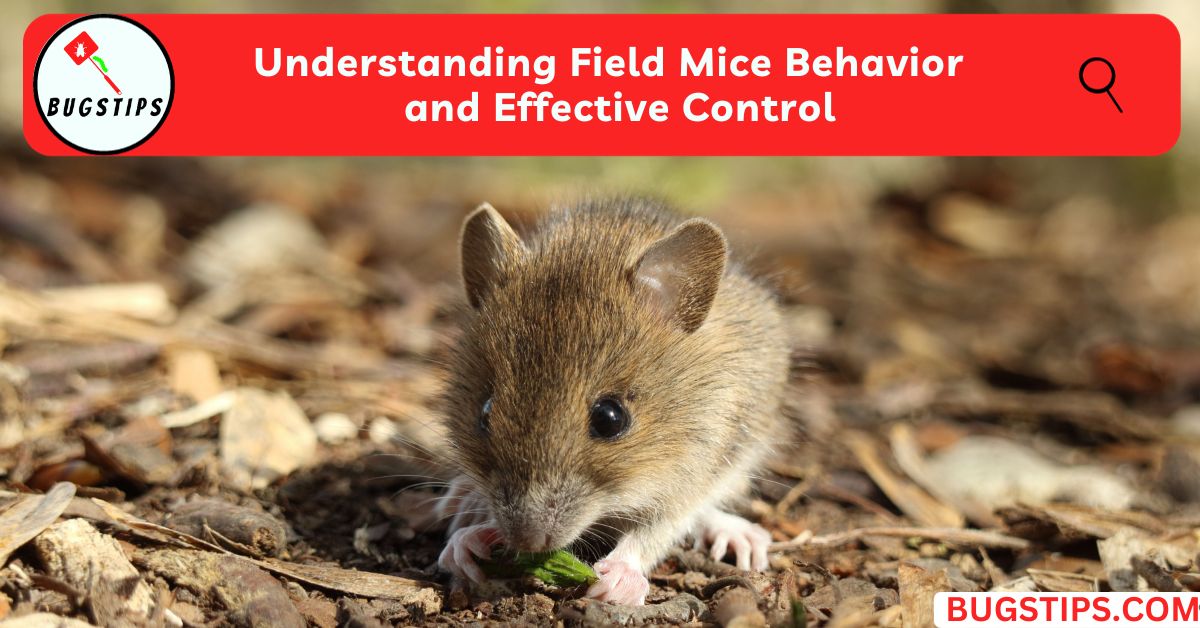This post may contain affiliate links which means as an Amazon Associate, this site may earn a small commission on qualified purchases made through links at no extra cost to you. Learn more on Affiliate Disclosure
Have you ever come across long skinny black bugs in your house and wondered what they are? Many people encounter these creepy crawlies and are unsure of what they are or how to get rid of them.
In this article, we’ll cover everything you need to know about long skinny black bugs in house, including those with wings and those that fly.
We’ll go over how to identify them and provide tips on how to get rid of them.
So, let’s dive in and find out more about these long skinny black bugs in house!
Long Skinny Black Bugs in House
While many people refer to black, skinny, and long bugs as “Long Skinny Black Bugs,” the truth is that there are numerous pests and bugs that can be found in your house.
It’s important to know how to identify these bugs and how to get rid of them if they pose a threat.
Some people refer to these bugs as “long skinny black bugs in house with wings” or “long skinny flying black bugs in house,” but in reality, each type of bug has its own specific name.
By the end of this article, you’ll have a better understanding of these bugs and be able to identify them without having to repeat the phrase “long skinny black bugs in house.“
Related Article – 14 Small Tiny Brown Bugs In House
Earwigs (Long Skinny Black Bug In House)
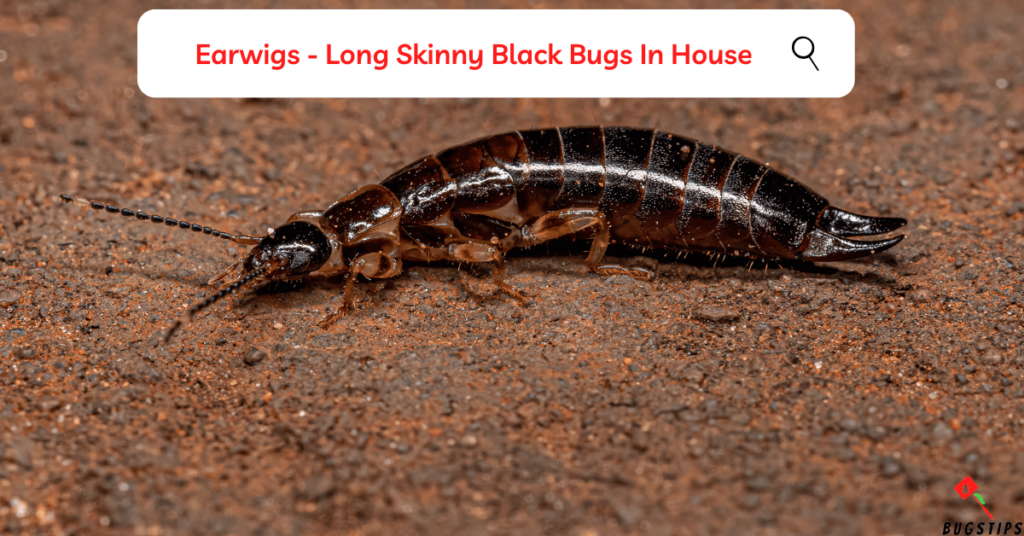
Earwigs are a common type of long skinny black bug that can be found in many homes. They are often referred to as “scary looking” because of their elongated body and pincers located at the end of their abdomen.
Earwigs belong to the order Dermaptera and are found all over the world, with the greatest diversity in the tropics.
While they may look intimidating, earwigs are not harmful to humans and are primarily a nuisance pest.
Related Article – Can Earwigs Fly? Here are the 10 Surprising Truth
How to Identify Earwigs
- Earwigs have large cerci, the forceps-like pincers protruding from their back end. Male cerci are bowed, and females are straight
- Earwigs are brown to reddish-brown in color and have long slim bodies with distinctive pinchers or “cerci” that stick out from their abdomen.
- The shape of their cerci is an easy way to tell if they are males or females. Females have a straight pair of cerci but male’s cerci are curved.
- Earwigs may or may not have wings depending on their species.
- Different types of earwigs include European earwigs, striped earwigs, and maritime earwigs, which have distinct physical characteristics such as size, color, and habitat.
Related Article – Baby Earwigs 101: Everything You Wanted to Know
How to Get Rid of Earwigs
Remove Any Standing Water or Damp Areas
- Earwigs are attracted to moisture, so eliminating any sources of standing water or damp areas in your home can help deter them.
Use Sticky Traps
- Place sticky traps in areas where earwigs are commonly found, such as near doorways, windows, and basements.
- These traps will capture the earwigs and prevent them from moving around your home.
Apply Insecticides
- Spray the insecticide in areas where earwigs are commonly found, such as along baseboards, in cracks and crevices, and in dark corners.
Create a Barrier
- Create a barrier around your home using diatomaceous earth.
- This natural powder can kill earwigs and other pests by dehydrating them.
- Sprinkle the powder around the perimeter of your home and in areas where earwigs are commonly found.
Related Article – Earwigs in Mailbox? 8 Proven Ways to Keep Them Out
Rove Beetles

Rove beetles are a family (Staphylinidae) of beetles that are primarily distinguished by their short elytra (wing covers) that typically leave more than half of their abdominal segments exposed.
These insects are a type of long skinny bug and are often black or dark brown in color. Rove beetles can be found in many different habitats, including forests, fields, and even in homes.
They are known for their elongated body shape and short wings, which can make them easily mistaken for other types of insects.
How to Identify Rove Beetles
- The elongated body of this genus has what appear to be four segments: a head, a thorax, a shortened elytra, and a long, slender abdomen.
- Rove beetles are easily recognized by their slender, usually black or brown body, and shortened front wings (elytra) that may look like pads on the abdomen.
- Most rove beetle adults are slender with short elytra; when of this typical form, the body shape ranges from cylindrical to much flatter.
- Rove beetles usually have very short wing covers, so several of their hind abdominal segments are exposed.
- The antennae usually have 11 segments and are filiform, with moderate clubbing in some genera.
- The abdomen may be very long and flexible, and some rove beetles superficially resemble earwigs.
Related Article – 12 Bugs That Look Like Bed Bugs
How to Get Rid of Rove Beetles
Remove Potential Food Sources
- Rove beetles feed on other insects, so eliminating their food sources can help reduce their numbers.
- Make sure to keep your home clean and free of crumbs and other food debris.
Vacuum Regularly
- Regularly vacuuming your home can help remove any rove beetles that may be hiding in carpets, rugs, or other soft surfaces.
Seal Cracks and Crevices
- Seal any cracks and crevices in your home where rove beetles may be entering.
- Use caulk or weather stripping to seal gaps around windows, doors, and other openings.
Thunder Bugs
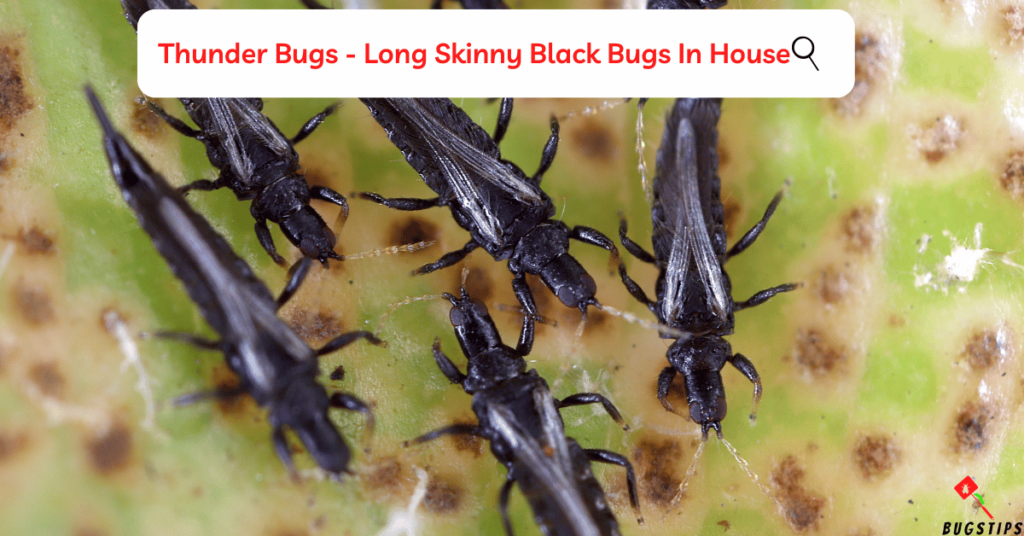
Thunderbugs, also known as thrips, are small, thin, yellow-brown, or black insects commonly found on flowers during the summer.
These pests are a type of long skinny black bug and can occasionally be found in homes.
Thunderbugs are named after their tendency to fly during thunderstorms, and they feed on plant sap by making an incision in a single cell with their left mandible and then inserting the maxillae and hypopharynx to pump out the juices of this and adjacent cells using a pharyngeal pump.
There are around 6,000 species of thrips, and they are commonly known as thunder flies, thunder bugs, storm bugs, corn flies, corn lice, thunder blights, and harvest flies.
Related Article – Do Thrips Bite?
How to Identify Thunder Bugs
- Thunderbugs are usually no longer than a couple of millimeters and seem to all of sudden appear everywhere – on food, on you – and they can become quite a nuisance
- The adult insects are narrow-bodied and up to 2mm in length.
- They have two pairs of strap-like wings, which are fringed with hairs, and these are folded back over the dorsal surface of the thrips when it is at rest.
- Thunderbugs are usually found near agricultural land.
How to Get Rid of Thunder Bugs
- Apply narrow-range oil, neem oil, or insecticidal soaps when the damage first begins to appear. These reduce the number of thrips which makes further control easier.
- Wipe them off the plant with a damp cloth or sponge.
- Hang sticky traps in the greenhouse to trap thrips and to act as an early warning system that thrips might be present. (These are not recommended for use outside as they might harm beneficial insects)
- Use biological control to control thrips in greenhouses, based on several species of predatory mites. This is available from some biological control suppliers.
- Remove any tape and hanging fixings from the back of the frame, take out the mount package and artwork, and use air to blow the insects off the print or mount.
Crickets
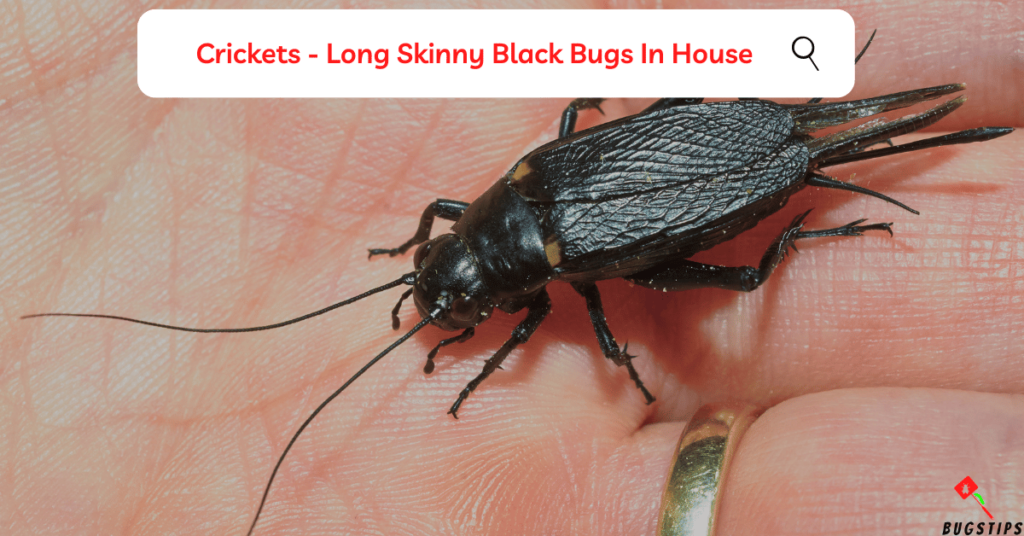
Crickets are a type of long skinny black bug that can be found in homes. They belong to the order Orthoptera and the family Gryllidae, and are known for their characteristic chirping sound, which is produced by rubbing their forewings together.
Crickets have a flattened body shape and are usually brown or black in color, making them easy to mistake for other types of long skinny black bugs.
How to Identify Crickets
- Crickets are often mistaken for grasshoppers. Both pests have large, strong, hind legs for jumping, but crickets are smaller and darker in color.
- Common house crickets are usually yellowish brown, while field crickets are shiny and black.
- Adult crickets measure about 1 inch in length and their bodies have three distinct segments: the head, the thorax, and the abdomen. They also have three pairs of legs.
- House crickets have a distinctive feature of three dark bands on their head.
- Tree crickets have a hint of orange colors if you look closely enough.
You May Also Like – 16 Green Bugs That Bite
How to Get Rid of Crickets
- Seal up your home’s exterior using caulks, expanding foam, sealants, rubber trim, and patching compounds to prevent crickets from entering your home.
- Use a vacuum cleaner to remove crickets from your home.
- Reduce moisture in your home or garden as crickets love moisture.
- Remove potential hiding spots such as piles of debris, woodpiles, and tall grasses.
- Use sticky traps to catch crickets.
- Use insecticides such as sprays, dusts, or baits to kill crickets.
- Use natural remedies such as diatomaceous earth, boric acid, or essential oils to repel or kill crickets.
Click Beetles

Click beetles are a type of long skinny black bug known for their ability to make an audible clicking sound when they are flipped onto their backs.
While not harmful to humans, they can be a nuisance pest and can be found in many different habitats, including fields, forests, and even in homes.
How to Identify Click Beetles
- Click beetles have long, somewhat flat bodies that may be tapered or rounded at the end.
- Their bodies appear segmented into two pieces, with the head and first pair of legs on one part and the wings and other two sets of legs on the second part.
- Most species of click beetles are brown or black, and some have red or yellow markings.
- Adult click beetles are black, brown, or grey and about 12 to 40 mm long. Some species have dark, round marks on their backs to mimic the eyes of larger animals.
- Click beetles larvae are known as wireworms due to their slender, segmented, and shiny appearance.
You May Also Like – 8 Bugs That Look Like Flying Termites
How to Get Rid of Click Beetles
- Use a vacuum cleaner to remove click beetles from your home and seal up the cracks, gaps, and holes they use to enter homes.
- Use insecticidal soap to kill click beetles outside your home or yard.
- Set bait stations to attract and kill click beetles.
- Hang traps around your lawn to catch click beetles.
- Remove decaying organic matter that is attracting click beetles to the area.
Weevils

Weevils are another type of bug that can look similar to long skinny black bugs. They belong to the family Curculionidae and are known for their elongated snouts, which they use to bore into plants and seeds.
Weevils are a common household pest, and they can be particularly problematic in areas where grains, cereals, and other dry foods are stored.
They can infest these foods, leaving behind their larvae and causing significant damage.
How to Identify Weevils
- Depending on the species, weevils range in size from about 3 mm to over 10 mm in length and are usually dark-colored (brownish to black).
- One of the distinguishing characteristics of weevils is their two spurs found on the femur of each of their front legs.
- The most distinctive feature of weevils is the shape of their head, which has a long snout.
Related Article – 8 Bugs That Look Like Lint and Bite
How to Get Rid of Weevils
- Dispose of any food items that are infested with weevils, and dispose of them immediately. This will help prevent the infestation from spreading.
- Use a vacuum cleaner to thoroughly clean your pantry or storage area. then wipe the shelves down with white vinegar.
- Use pheromone traps to attract and kill weevils.
- Use diatomaceous earth to kill weevils. Sprinkle it around your pantry or storage area, and it will dehydrate and kill the weevils.
- If you have any infested food items that you want to keep, you can freeze them for at least three days. This will kill any weevils or larvae that may be present.
- Use bay leaves to repel weevils. Bay leaves are a natural weevil repellent. Place a few bay leaves in your pantry or storage area to help keep weevils away.
Silverfish and Firebrats

Silverfish and Firebrats are two types of insects that are often mistaken for long skinny black bugs in the house. While they are similar in shape and size, they differ in their coloration.
Silverfish are typically silver or gray in color and have long, slender bodies that taper towards the rear.
They are often found in damp areas such as bathrooms, kitchens, and basements.
Related Article – Do Silverfish Bite? Debunking the Myth
Firebrats, on the other hand, are usually mottled brown and have a more flattened body shape. They are often found in areas with high heat, such as near ovens or hot water pipes.
Both Silverfish and Firebrats are common household pests and can cause damage to books, clothing, and other items.
They are attracted to starchy or sugary substances and can often be found in pantries or near food storage areas.
How to Identify Silverfish and Firebrats
Silverfish
- The common silverfish, Lepisma saccharina, is shiny, silver, or pearl gray, and about 1/2 inch long, although it can grow as long as 3/4 inch.
- They have flat, elongated bodies that taper from head to tail, giving them a fish-like appearance.
- Silverfish prefer dry food such as cereals, flour, pasta, and pet food; paper with glue or paste; and starched clothing.
Related Article – What Do Silverfish Eat? Shocking List of Foods
Firebrats
- The common firebrat, Thermobia domestica, is shiny, a mottled gray or brown, and about 1/2 inch long.
- They have flat, elongated bodies that taper from head to tail.
- They have greyish-brown scales on their bodies that produce a speckled or mottled appearance.
- Firebrats prefer hot, humid places such as attics in the summer and furnaces, fireplaces, and heat pipes in the winter.
Silverfish and Firebrats are very similar in appearance and can be difficult to tell apart. Both insects are nocturnal and hide during the day.
How to Get Rid of Silverfish and Firebrats
- Use Sticky Traps: Professional sticky bug traps can be used in closets, drawers, and chests to capture silverfish and firebrats.
- Use Scented Herbs and Spices: Strongly scented herbs and spices such as cinnamon sticks, bay leaves, or cloves have been known to repel silverfish.
- Use Borax: Borax is an effective way to kill silverfish. Spread a thin layer of borax in areas where silverfish are present, such as in cracks and crevices.
- Use Small Glass Containers: Silverfish and firebrats can be easily trapped in small glass containers like baby food jars. Wrap the outside of the glass with tape and set them out in areas where the pests are present.
- Reduce Humidity: Silverfish and firebrats thrive in humid environments, so reducing humidity levels can help deter them. Use a dehumidifier or air conditioner to reduce humidity levels.
Related Article – How to Get Rid of Silverfish in Bathrooms
Water Scorpions
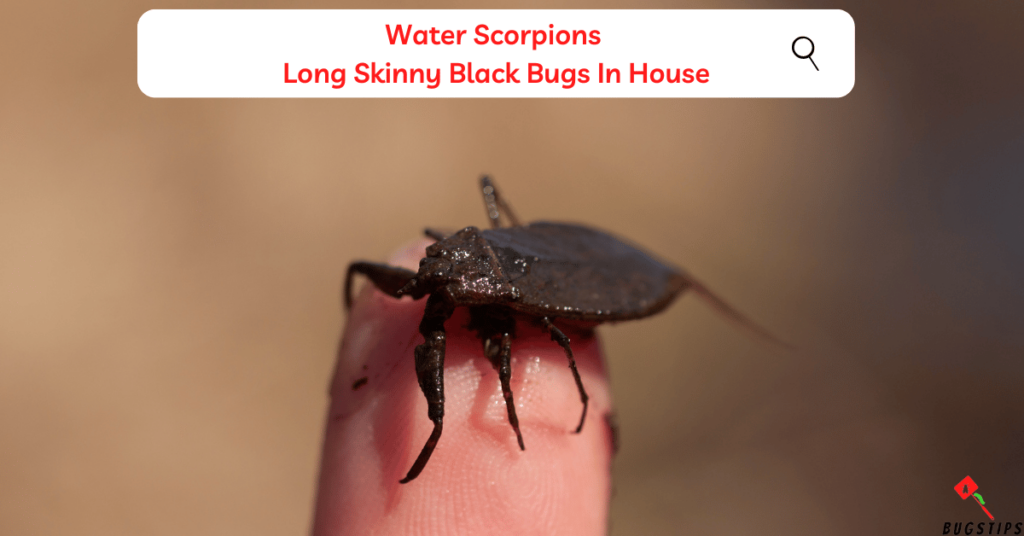
While you may not find Water Scorpions in your home, these fascinating insects are often mistaken for long skinny black bugs in the water.
They are aquatic insects that are found in freshwater habitats such as ponds, streams, and lakes, and are known for their elongated body and long, slender legs that resemble those of a scorpion.
Despite their name, Water Scorpions are not true scorpions and do not possess a stinger.
How to Identify Water Scorpions
- Water Scorpions are dark brown in color and measure about 25 to 52 millimeters (1 to 2 inches) in length.
- They have a flattened, leaf-shaped body and a long, thin, whiplike structure at their posterior end.
- Water Scorpions have scythelike front legs adapted for seizing prey.
- Water Scorpions live primarily along the bottom edges of slow-moving streams or ponds, clinging to twigs or pond vegetation, head down, waiting to ambush their prey.
Related Article – 9 Types of Swimming Pool Bugs
How to Get Rid of Water Scorpions
- Eliminate standing water that will attract Water Scorpions and other pests.
- Elevate potted plants from the ground and do not overwater them.
- Trim back bushes and trees that are leaning onto your house or touching the ground.
- If you have a swimming pool, use a pool cover to prevent Water Scorpions from entering the pool.
Stilt Bugs
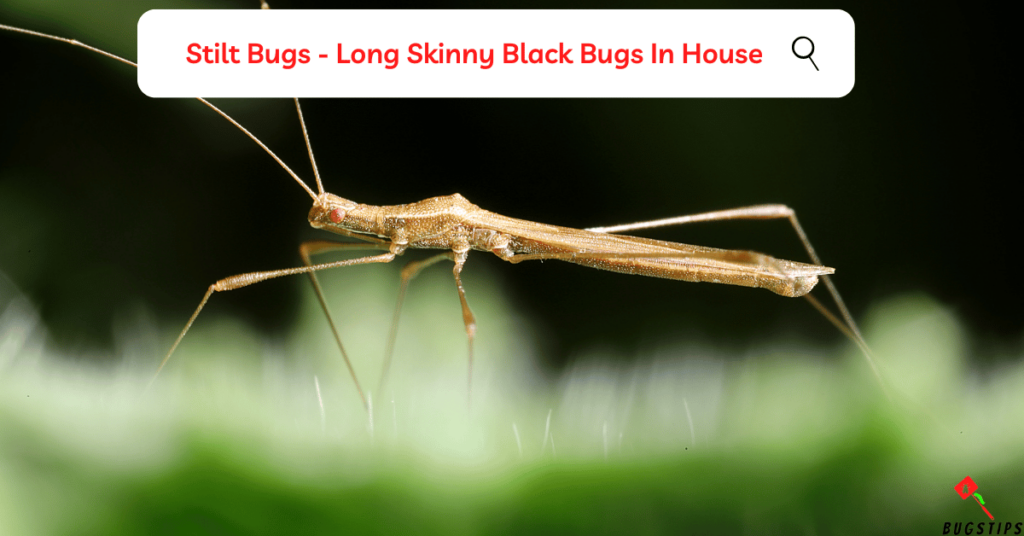
Stilt Bugs are another type of insect that people may mistake for long skinny bugs.
They belong to the family of true bugs known as Berytidae and are known for their long and slender legs that give them a stilt-like appearance.
Stilt Bugs are typically found in outdoor habitats such as fields, forests, and gardens.
Stilt Bugs feed on the pollen and nectar of plants and are not considered harmful to plants.
While they can be pests of crops such as tomatoes, they are not commonly found indoors or in homes.
In fact, Stilt Bugs prefer to live in open areas with plenty of vegetation where they can feed and reproduce.
You May Also Like – White Bugs on Plants
How to Identify Stilt Bugs
- Stilt Bugs are 5 to 9 mm (0.2 to 0.4 inch) long and are brown to blend in with the dense vegetation on which they are found.
- They have long antennae with a small club.
- Stilt Bugs earned their common name from their very long legs.
- All Stilt Bug species are plant feeders and are typically found on dense vegetation.
There are approximately 100 species of Stilt Bugs, and some species can be confused with other bugs such as Jalysus spinosus.
Related Article – 12 Tiny Black Bugs on Window Sill
How to Get Rid of Stilt Bugs
- Prune any infested plants to remove the Stilt Bugs.
- Use insecticidal soap to control Stilt Bug populations. Spray the plants thoroughly, including the undersides of leaves where Stilt Bugs are often found.
- Neem oil is an effective and natural insecticide that can be used to control Stilt Bugs. Mix neem oil with water and spray the plants thoroughly.
- Diatomaceous earth is a natural substance that can be used to control Stilt Bugs. Sprinkle it around the base of the plant and on the leaves where Stilt Bugs are often found.
- Sticky traps can be used to catch Stilt Bugs and reduce their population in your garden.
Stilt Bugs are beneficial insects that help pollinate flowers and control other insect populations in your garden. If you have a small infestation of Stilt Bugs, it may be better to leave them alone and let them do their job.
Related Article – 15 Tiny Yellow Bugs
Final Thoughts
Long skinny black bugs in house can be a common sight, but not all of them are the same.
While some of these insects can be considered pests that can harm your home and garden, others are beneficial insects that can help control pests and nurture the environment.
Therefore, it is important to be careful when trying to get rid of them and to understand their role in the ecosystem.
Now that you know more about these long skinny black bugs, you can identify them more accurately and take appropriate measures to manage them if necessary.
By keeping your home clean and dry, sealing up cracks and crevices, and using natural pest control methods, you can help prevent infestations and keep your home and garden healthy.
With this knowledge, you can coexist with these fascinating insects and appreciate their unique qualities and behaviors.
FAQs
What is the black earwig-looking bug?
The black earwig-looking bug is likely the Devil’s coach horse, which is a long, black beetle with short wing cases.
Although it may resemble an earwig at first glance, it is a distinct species.
Is the long skinny flying black bug in house dangerous?
generally speaking, most bugs that fly are not dangerous to humans. However, some bugs can be harmful to plants and structures in your house.
What is a long black bug that looks like a worm?
A long black bug that looks like a worm is likely a millipede. Millipedes are arthropods with long, segmented bodies and numerous legs.
They are often found in damp areas such as basements and crawl spaces.
What are long black skinny worms?
Long black skinny worms may refer to horsehair or gordian worms, which are long, slender worms related to nematodes.
These worms are typically found in freshwater habitats and are not harmful to humans or pets.
Resources – (for further reading)
University of Minnesota – Earwigs, Rove Beetle, Crickets, Click Beetle, Home-invading weevils
UC ANR – Silverfish and Firebrat Management Guidelines–UC IPM
Britannica – Thrips and their species, Water scorpion | insect, Stilt Bug

